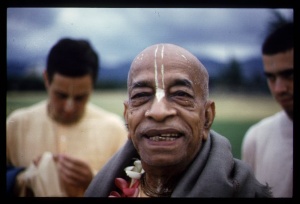SB 4.6.38: Difference between revisions
m (1 revision(s)) |
No edit summary |
||
| Line 1: | Line 1: | ||
{{info | {{info | ||
|speaker=Maitreya | |speaker=Maitreya Ṛṣi | ||
|listener=Vidura | |listener=Vidura | ||
}} | }} | ||
[[Category:Srimad-Bhagavatam - Canto 04 Chapter 06]] | |||
[[Category:Bhagavatam Verses Spoken by Maitreya Rsi - Vanisource|040638]] | |||
<div style="float:left">'''[[Srimad-Bhagavatam]] - [[SB 4|Fourth Canto]] - [[SB 4.6: Brahma Satisfies Lord Siva|Chapter 6: Brahmā Satisfies Lord Śiva]]'''</div> | |||
<div style="float:right">[[File:Go-previous.png|link=SB 4.6.37]] '''[[SB 4.6.37]] - [[SB 4.6.39]]''' [[File:Go-next.png|link=SB 4.6.39]]</div> | |||
{{RandomImage}} | |||
==== TEXT 38 ==== | ==== TEXT 38 ==== | ||
<div | <div class="verse"> | ||
kṛtvorau dakṣiṇe savyaṁ | :kṛtvorau dakṣiṇe savyaṁ | ||
pāda-padmaṁ ca jānuni | :pāda-padmaṁ ca jānuni | ||
bāhuṁ prakoṣṭhe 'kṣa-mālām | :bāhuṁ prakoṣṭhe 'kṣa-mālām | ||
āsīnaṁ tarka-mudrayā | :āsīnaṁ tarka-mudrayā | ||
</div> | </div> | ||
| Line 16: | Line 22: | ||
==== SYNONYMS ==== | ==== SYNONYMS ==== | ||
<div | <div class="synonyms"> | ||
''kṛtvā''—having placed; ''ūrau''—thigh; ''dakṣiṇe''—at the right; ''savyam''—the left; ''pāda-padmam''—lotus feet; ''ca''—and; ''jānuni''—on his knee; ''bāhum''—hand; ''prakoṣṭhe''—in the end of the right hand; ''akṣa-mālām''—rudrākṣa beads; ''āsīnam''—sitting; ''tarka-mudrayā''—with the mudrā of argument. | |||
</div> | </div> | ||
| Line 23: | Line 29: | ||
==== TRANSLATION ==== | ==== TRANSLATION ==== | ||
<div | <div class="translation"> | ||
His left leg was placed on his right thigh, and his left hand was placed on his left thigh. In his right hand he held rudrākṣa beads. This sitting posture is called vīrāsana. He sat in the vīrāsana posture, and his finger was in the mode of argument. | His left leg was placed on his right thigh, and his left hand was placed on his left thigh. In his right hand he held rudrākṣa beads. This sitting posture is called vīrāsana. He sat in the vīrāsana posture, and his finger was in the mode of argument. | ||
</div> | </div> | ||
| Line 30: | Line 36: | ||
==== PURPORT ==== | ==== PURPORT ==== | ||
<div | <div class="purport"> | ||
The sitting posture described herein is called vīrāsana according to the system of aṣṭāṅga-yoga performances. In the performance of yoga there are eight divisions, such as yama and | The sitting posture described herein is called ''vīrāsana'' according to the system of ''aṣṭāṅga-yoga'' performances. In the performance of yoga there are eight divisions, such as ''yama'' and ''niyama''—controlling, following the rules and regulations, then practicing the sitting postures, etc. Besides ''vīrāsana'' there are other sitting postures, such as ''padmāsana'' and ''siddhāsana''. Practice of these ''āsanas'' without elevating oneself to the position of realizing the Supersoul, Viṣṇu, is not the perfectional stage of yoga. Lord Śiva is called ''yogīśvara,'' the master of all ''yogīs,'' and Kṛṣṇa is also called ''yogeśvara''. ''Yogīśvara'' indicates that no one can surpass the ''yoga'' practice of Lord Śiva, and ''yogeśvara'' indicates that no one can surpass the yogic perfection of Kṛṣṇa. Another significant word is ''tarka-mudrā''. This indicates that the fingers are opened and the second finger is raised, along with the arm, to impress the audience with some subject matter. This is actually a symbolic representation. | ||
</div> | </div> | ||
__NOTOC__ | |||
<div style="float:right; clear:both;">[[File:Go-previous.png|link=SB 4.6.37]] '''[[SB 4.6.37]] - [[SB 4.6.39]]''' [[File:Go-next.png|link=SB 4.6.39]]</div> | |||
__NOTOC__ | |||
__NOEDITSECTION__ | |||
Revision as of 13:13, 7 May 2021

A.C. Bhaktivedanta Swami Prabhupada
TEXT 38
- kṛtvorau dakṣiṇe savyaṁ
- pāda-padmaṁ ca jānuni
- bāhuṁ prakoṣṭhe 'kṣa-mālām
- āsīnaṁ tarka-mudrayā
SYNONYMS
kṛtvā—having placed; ūrau—thigh; dakṣiṇe—at the right; savyam—the left; pāda-padmam—lotus feet; ca—and; jānuni—on his knee; bāhum—hand; prakoṣṭhe—in the end of the right hand; akṣa-mālām—rudrākṣa beads; āsīnam—sitting; tarka-mudrayā—with the mudrā of argument.
TRANSLATION
His left leg was placed on his right thigh, and his left hand was placed on his left thigh. In his right hand he held rudrākṣa beads. This sitting posture is called vīrāsana. He sat in the vīrāsana posture, and his finger was in the mode of argument.
PURPORT
The sitting posture described herein is called vīrāsana according to the system of aṣṭāṅga-yoga performances. In the performance of yoga there are eight divisions, such as yama and niyama—controlling, following the rules and regulations, then practicing the sitting postures, etc. Besides vīrāsana there are other sitting postures, such as padmāsana and siddhāsana. Practice of these āsanas without elevating oneself to the position of realizing the Supersoul, Viṣṇu, is not the perfectional stage of yoga. Lord Śiva is called yogīśvara, the master of all yogīs, and Kṛṣṇa is also called yogeśvara. Yogīśvara indicates that no one can surpass the yoga practice of Lord Śiva, and yogeśvara indicates that no one can surpass the yogic perfection of Kṛṣṇa. Another significant word is tarka-mudrā. This indicates that the fingers are opened and the second finger is raised, along with the arm, to impress the audience with some subject matter. This is actually a symbolic representation.